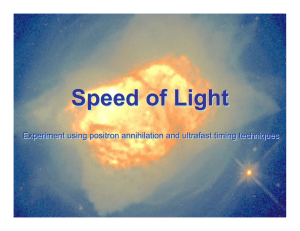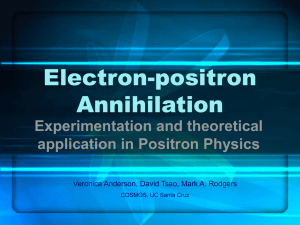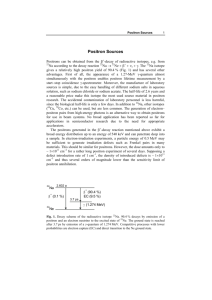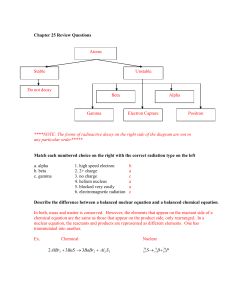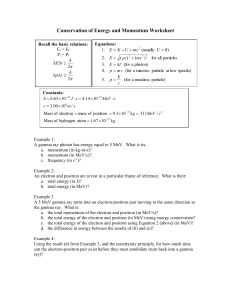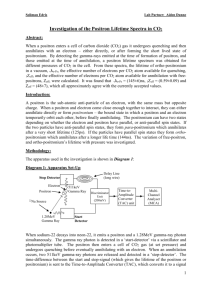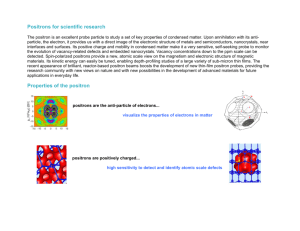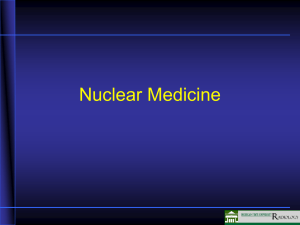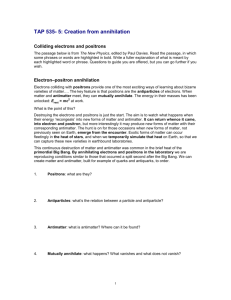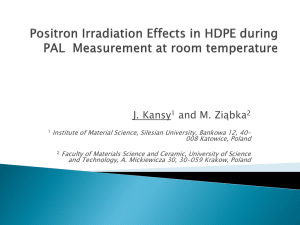Measuring Positron Mass Using Gamma
advertisement
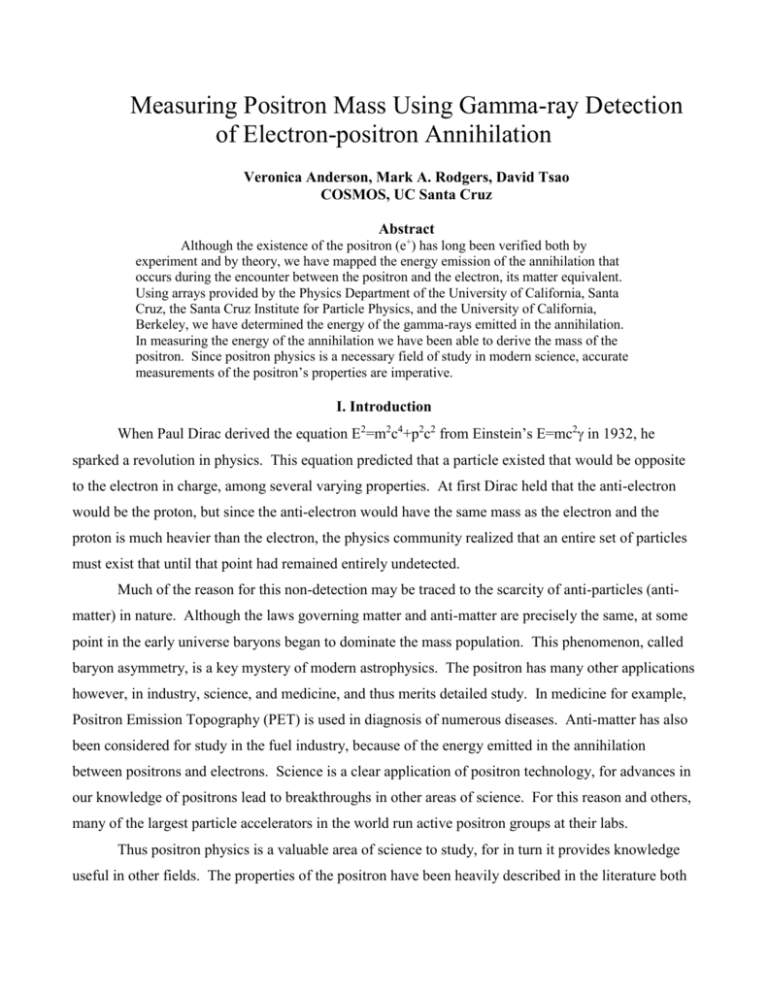
Measuring Positron Mass Using Gamma-ray Detection of Electron-positron Annihilation Veronica Anderson, Mark A. Rodgers, David Tsao COSMOS, UC Santa Cruz Abstract Although the existence of the positron (e+) has long been verified both by experiment and by theory, we have mapped the energy emission of the annihilation that occurs during the encounter between the positron and the electron, its matter equivalent. Using arrays provided by the Physics Department of the University of California, Santa Cruz, the Santa Cruz Institute for Particle Physics, and the University of California, Berkeley, we have determined the energy of the gamma-rays emitted in the annihilation. In measuring the energy of the annihilation we have been able to derive the mass of the positron. Since positron physics is a necessary field of study in modern science, accurate measurements of the positron’s properties are imperative. I. Introduction When Paul Dirac derived the equation E2=m2c4+p2c2 from Einstein’s E=mc2 in 1932, he sparked a revolution in physics. This equation predicted that a particle existed that would be opposite to the electron in charge, among several varying properties. At first Dirac held that the anti-electron would be the proton, but since the anti-electron would have the same mass as the electron and the proton is much heavier than the electron, the physics community realized that an entire set of particles must exist that until that point had remained entirely undetected. Much of the reason for this non-detection may be traced to the scarcity of anti-particles (antimatter) in nature. Although the laws governing matter and anti-matter are precisely the same, at some point in the early universe baryons began to dominate the mass population. This phenomenon, called baryon asymmetry, is a key mystery of modern astrophysics. The positron has many other applications however, in industry, science, and medicine, and thus merits detailed study. In medicine for example, Positron Emission Topography (PET) is used in diagnosis of numerous diseases. Anti-matter has also been considered for study in the fuel industry, because of the energy emitted in the annihilation between positrons and electrons. Science is a clear application of positron technology, for advances in our knowledge of positrons lead to breakthroughs in other areas of science. For this reason and others, many of the largest particle accelerators in the world run active positron groups at their labs. Thus positron physics is a valuable area of science to study, for in turn it provides knowledge useful in other fields. The properties of the positron have been heavily described in the literature both experimentally and theoretically. However, in order that we should better understand the properties of the positron itself, and to confirm the theoretical prediction that the positron should have the same mass as the electron, we have sought to accurately measure the mass of a positron. II. Procedure II.1 As a positron source we used an isotope of Sodium, 22Na. This isotope of sodium is primarily a source, emitting only a very small number of gamma rays (.1% of all particles emitted). The source was stored in a cavity of air encased within a structure of lead shielding. When a positron from the 22Na was emitted, it was likely to collide with an electron within the air cavity. A Saint Gobain Sodium Iodide Scintillator was used to detect the gamma rays emitted from the annihilation of the electron and positron. The output from the Sodium Iodide was fed into a Digital Oscilloscope and into a Canberra 35-Series Multi-channel Analyzer. II.2 It is possible to find the mass of a positron indirectly by finding the energy of the rays emitted in its annihilation with an electron. Through Einstein’s relation of mass and energy, the energy detected in the annihilation is directly correlated with the original mass of the positron, and the conversion is easily calculable. The photons emitted from the annihilation of the electron and positron carry the energy of those particles—both their kinetic energy and their inertial energy of mc2. In order to minimize the kinetic energy of the electrons during the annihilation, we placed an aluminum shield between the source and the Scintillator. The kinetic energy of the positrons is negligible however, as it is slowed by neighboring electrons to thermal energies. Around the aluminum shield, source, and detector we built an enclosure of lead bricks. The bricks measured 1050 cm3 each,5 cm in thickness, enough to minimize the energy and penetration of cosmic gamma-rays, reducing noise in our detector. The power supply for the Sodium Iodide was somewhat difficult to procure. We supplied +580 V directly to the detector, using a high pass filter to fix the negative DC offset on the high voltage source in addition to feeding –24 V in lieu of a preamplifier. When the 22Na emitted a positron into the aluminum absorber, two annihilation gamma-rays are emitted, one of which may be detected by the Scintillator (the gamma-rays are emitted linearly in opposite directions). To determine the mass of the positron itself, we subtracted half of the mass energy of an electron—due to the limitation of only one Scintillator—from the energy of the one we were able to detect, and are left with half of the massenergy and the half the kinetic energy of a positron. III. Results III.1 After finishing our experimental runs we looked at the distribution of counts on the data collected while using the sodium-22 source and the distribution of background noise. The spectra for background noise had counts that were negligible compared to the actual data collected when the positron source was present, and so we were able to go ahead and analyze the date from the sodium-22 source without having to worry about correcting for the background noise. We found that the data peaked very strongly at approximately bin # 318, which, according to our calibration corresponds to an energy of 537.181 kev. In order to properly calculate the mass energy, this value must be converted to Joules and then plugged into Einstein’s equation E=mc2. When all the values are plugged in, the result for the mass of the positron turned out to be 9.5449x10-31 kg, which is extremely close to the mass of an electron, 9.1095x10-31 kg. The small discrepancy between our calculated value and our expected value is within a reasonable margin of error given our possibly inaccurate calibration techniques, so we can reasonably conclude that the positron and the electron have equivalent masses, as predicted. IV. Conclusion IV.1 With our experimental data of a positrons’ mass matching the theoretical mass with an percent error of about 5%, we can safely assume that yes, positrons do have the same mass as electrons, and that the slight deviation were due to several experimental errors, as well as lack of time. Firstly, although we tried to use two sources to calibrate the NaI(Tl) Scintillator, Ba 133 gave us counts that were actually slightly below the background noise, so we were unable to use it for calibration. Another main source of error includes the fact that we did take into account the thermal kinetic energies of the electrons and positrons. Next time, to take this experiment further, we would adjust for all of the above mentioned difficulties, especially the time constraint we had. One more major detail we would take into account is the fact that we did not actually average the energies of the positron or calibration source, but only took their peak value, which would have bumped our results up slightly. To conclude, we were quite happy with the results we got, and would have liked to have more time to set our experiment up more carefully, and also to possibly explore the matter anti-matter asymmetry problem further.
